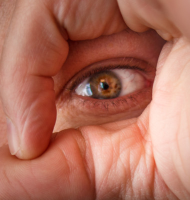I do a version of the "wallpaper" method you mentioned. Not stacked, more of a storyboard hidden in Fog Of War. I make a big background page (180x250 or whatever), that starts blank (naturally) and I like a slate grey, dark grey background. I turn on the Fog Of War, that hides the entire page in blackness to the Players' eyes. Use reveal tool to carve out a see-able area at the Top Left. That's the normal place for your player to look. If your players keep a Token for tracking health or whatever, place their token in the "safe area" at the top left. Also if you have a homeland picture, origin picture, or character portraits that are already known, place those in the visible safe area at the top left also. I let my Players propose & send me pictures that they want up here, like a picture of their weapons, their symbol, a detail of their character's haircut, wanted poster for their worst enemy, whatever. Then I paste the DM's upcoming pictures like wallpaper all over the rest of the page, hidden in the Fog Of War. Make a hidden storyboard of illustrations. I keep a column on the right side for monster tokens and images that I might "pull in" to the top-left visible area on a moment's notice. More importantly, I make rows and rows of cinematic pictures, images, scenes as Vince described. These pictures are roughly in a storyboard sequence, however the Players might skip around the storyboard rather than proceeding in the order I've placed the pictures, and that's OK and works fine with my wallpaper approach. I just keep them in rows for sections, they might encounter 1 or more pictures from any given row, or they might move around the page. Example, all the Swamp scenes on a row. All the Town scenes on another row. Camping scenes on another row. So there might be 4-8 different camping scenes queued up, waiting to see which one gets used next. When it's time to move to that scene, reveal the picture from the Fog & shift-Ping to bring the player's focus to that part of the wallpaper . That's the key DM technique that I use for doing the wallpaper /storyboard /flashcards /illustrations on Roll20. Sometimes I will announce, like "Zoom yourself to 200% and then I will ping you to the spot". If I want them to see the picture fairly large and full screen, but I don't want to stretch the picture so big on my wallpaper. Of course they can still zoom in & out when they get there, but sometimes it is nice to tell the players to be zoomed-in before you do the reveal & ping. It leads to a patchwork. They can see "Ahhh we revealed several Swamp-scene pictures on that row... but there's still some hidden black spots, I guess we missed something..". It leaves some mystery. By reducing the Fog Of War opacity (around 70% dark works), GM can see what scenes are available, coming up, and decide what to reveal next. I use multiple Pages that are each this big. There is 1 page for each Player (so every Character has their own personal page with storyboard hidden and revealed). Then 1 page for whatever adventure we are on, collectively as a party, the current session or story line. Another page is a world map, with more pictures hidden around the borders.



